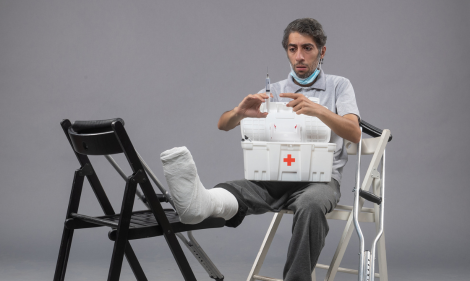Car accidents often cause an immediate rush of adrenaline, masking pain and symptoms for hours or even days. While you may walk away feeling unscathed, hidden injuries can develop silently beneath the surface — only revealing themselves when complications set in.
At Specialty Care Clinics, we specialize in identifying these delayed-onset injuries, ensuring early diagnosis, precise care, and long-term recovery.

How Hidden Injuries Occur
After a collision, the body undergoes sudden acceleration and deceleration forces. The impact affects muscles, joints, and internal organs even when external damage appears minimal.
Here’s why injuries may stay hidden initially:
- Adrenaline surge: Masks pain signals and inflammation.
- Soft tissue swelling: Takes time to develop after trauma.
- Delayed nerve response: Nerve compression or strain may not cause pain immediately
- Internal trauma: Organ or vessel damage can progress silently.
Even low-speed crashes can cause whiplash, concussions, or internal bleeding — all of which may appear days later.
Common Hidden Injuries After a Car Accident
1. Whiplash and Neck Strain
Cause: Sudden back-and-forth motion of the head during impact.
Symptoms: Neck stiffness, headaches, shoulder or upper back pain.
Learn more: Neck Pain and Whiplash
2. Soft Tissue Injuries
Cause: Overstretching or tearing of muscles, ligaments, and tendons.
Symptoms: Pain, swelling, reduced mobility appearing after 24–48 hours.
Visit: Soft Tissue Injury Treatment
3. Concussions and Mild Head Injuries
Cause: Sudden jolt or blow to the head, even without visible impact.
Symptoms: Dizziness, nausea, confusion, blurred vision, or memory lapses.
Learn more: Head Injuries
4. Internal Bleeding or Organ Damage
Cause: Seatbelt pressure or blunt force trauma to the abdomen or chest.
Symptoms: Abdominal pain, fainting, dizziness, or low blood pressure — a medical emergency.
Read more: Internal Bleeding
5. Spinal or Nerve Injuries
Cause: Compressed nerves or spinal misalignment from the crash.
Symptoms: Tingling, numbness, weakness, or shooting pain in limbs.
Visit: Spinal Cord Injuries
Warning Signs That Require Immediate Attention
Even if symptoms appear minor, seek medical help if you notice:
- Persistent headaches or dizziness
- Increasing stiffness or swelling
- Pain radiating to arms, legs, or back
- Vision changes or confusio
- Shortness of breath or chest tightness
- Abdominal tenderness or bloating
Prompt care can prevent life-threatening complications like internal bleeding, nerve damage, or chronic pain syndromes.
Diagnosis at Specialty Care Clinics
Our specialists use a thorough, evidence-based diagnostic approach to uncover hidden trauma:
- Comprehensive Physical Examination: Assesses pain, movement, and swelling.
- Digital Imaging (X-ray, CT, MRI): Detects fractures, soft tissue injuries, and internal bleeding.
- Neurological Testing: Evaluates reflexes, coordination, and cognitive response.
- Functional Assessment: Measures strength, flexibility, and balance for recovery planning.
Accurate and early diagnosis ensures the right treatment before complications develop.
Treatment Options for Hidden Injuries
Mild to Moderate Injuries (Whiplash, Strains, Concussions):
- Rest and limited activity
- Ice or heat therapy
- Pain management medications
- Physical therapy and posture correction
- Cognitive rest for head injuries
Severe Injuries (Internal Bleeding, Nerve Compression):
- Hospitalization and monitoring
- Surgical intervention if needed
- Long-term rehabilitation and physiotherapy
- Pain management and strengthening programs
At Specialty Care Clinics, we design individualized care plans to restore comfort, mobility, and confidence after trauma.
Recovery and Rehabilitation
Recovery time varies depending on the type and severity of injuries.
Our specialists guide patients through:
- Gradual physical therapy to restore muscle strength and joint flexibility
- Chiropractic care for spinal alignmen
- Breathing and relaxation exercises for pain management
- Regular follow-up assessments to monitor improvement
Early rehabilitation promotes long-term recovery and prevents recurring pain.
Preventing Long-Term Complications
Hidden injuries that go untreated may lead to:
- Chronic neck or back pain
- Limited mobility
- Nerve damage or herniated discs
- Emotional distress or sleep disturbances
Tips to Protect Your Health:
- Seek medical evaluation within 24–48 hours after any crash
- Follow through with all diagnostic tests and prescribed therapy
- Avoid heavy lifting or high-impact exercise during early recovery
- Always wear your seatbelt correctly and adjust your headrest for protection
Don’t wait for symptoms to worsen — get evaluated at Specialty Care Clinics – Auto Injury.
Conclusion
Just because you feel fine after a car accident doesn’t mean you’re injury-free. Hidden injuries like whiplash, internal bleeding, and concussions can take time to show but may have lasting effects if ignored.
At Specialty Care Clinics, our experienced medical team provides advanced imaging, accurate diagnosis, and customized rehabilitation to help you recover safely and fully.
Don’t let delayed pain become permanent damage — seek professional evaluation today.
Visit Specialty Care Clinics – Auto Injury for expert post-accident care.
FAQs
Q1. Why do some car accident injuries show up days later?
Because of adrenaline and inflammation, symptoms may take 24–72 hours to appear.
Q2. What are the most common hidden injuries after an accident?
Whiplash, soft tissue damage, concussions, and internal bleeding are the most frequent.
Q3. Should I visit a doctor if I don’t feel pain after a crash?
Yes — early evaluation can detect hidden damage before it worsens.
Q4. How long does it take for hidden injuries to heal?
Mild injuries may heal in a few weeks; severe or untreated injuries may take months.
Q5. Why choose Specialty Care Clinics for post-accident care?
We offer complete diagnostic testing, expert treatment, and guided rehabilitation for all types of auto injuries.
